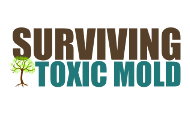Stages of Mycotoxicosis: For Inhalation of Mycotoxin
By Dr. William Croft
The three Stages (1-3) ranging from lower to higher severity of poisoning were modified according to exposure via the air as opposed to ingestion already established (Forgacs et al., 1962; Joffe, 1971). A separate Stage of convalescence occurs when a patient is completely removed from the contaminated premises and the source of mycotoxin or mold spores.
Stage 1:
The primary changes are in the brain, respiratory and immune systems, mucus membranes and gastrointestinal tract. Signs and symptoms may include burning sensation in the mouth, tongue, throat, palate, esophagus, and stomach, which is a result of the action of the toxin on the mucous membranes and skin in the exposed areas.
Moist areas of the body armpits, under breasts, belt line and groin are more sensitive or first affected. Patients may report burning within the eyes, ears and nose. Patients also reported that their tongues felt swollen and stiff. Mucosa of the oral cavity may be hyperemic. Mild gingivitis, stomatitis, glositis, and esophagitis developed. Inflammation, in addition to gastric and (small and large) intestinal mucosal, resulted in vomiting, diarrhea and abdominal pain. Excessive salivation, headache, dizziness, weakness, fatigue and tachycardia were also present. There may be fever and sweating. The respiratory system develops burning sensations and congestion. Severe exposure to mycotoxinwithin the lungs may lead to congestion, edema and failure, due to caustic action. Body temperature remains normal and controllable bythe patient. The poisoning appears and disappears relatively quickly in this Stage with the exception of, lungs and central nervous system. Initially (Stage 1), the patient's symptoms are very uncomfortable or painful. As the poisoning continues and the patient progress toward Stage 2, he or she becomes accustomed to the presenceof the mycotoxin and a quiescent period follows due to lack of nerve sensation. Depending on exposure levels, the first Stage may last from 3 - 9 days. In scoring the 50 signs and symptoms listed in Tables-1 and 2, an average score range of 20-45 represents Stage 1.
Stage 2:
This Stage is often called the latent Stage or incubation period because the patient feels apprehensive, but is capable of normal activity in the beginning of this Stage. Every organ of the body is affected by degeneration and necrosis with continued exposure. The primary target organs for an individual become evident over time, due to biological variation.
These are disturbances in the central and autonomic nervous systems resulting in headaches, mental depression, loss of short-term memory, loss of problem-solving ability, various neuropsychiatric manifestations, meningism, severe malaise and fatigue, narcolepsy, loss of temperature control, hyperesthesia or numbness of body areas, and cerebellar dysfunction including hypotonia, attitude and gait, dysmetria, asthenia, vertigo, disturbances of speech, and loss of balance (Best, 1961).
Spinal corddegeneration may also be observed in gait and reflex abnormalities,such as the ability to drive vehicles, ride bicycles or pass sobriety tests (inability to tolerate ethyl alcohol).
Attention deficient disorder may be observed in children.
Various systems may include:
Eyes: visual disturbances, floating objects, light sensitive, lack of tears, burning and itching.
Ears: burning, itching, and loss of hearing. Immune and hematopoietic: progressive loss of white and red cells including a decrease of platelets and hemoglobin, and high susceptibility to bacterial, mycotic and viral infections, debilitating chemical and allergies.
Gastrointestinal: metallic taste in mouth, tooth loss, gum problems, stomatitis, sores in gums and throat, nausea, vomiting, diarrhea or constipation, excessive flatulence, abdominal distention, hepatitis, pancreatitis, and diabetes mellitus.
Respiratory: burning and bleeding from nasal membranes, respiratory difficulty, asthma, extreme susceptibility to cold, flu and pneumonia.
Skin: thinning of hair on head, burning on face, rashes, irritation, and edema.
Renal: proteinuria, possible hematuria.
Reproductive: irregular ovarian cycles, increased menstrual flow, fibroid growths in uterus, cystic development inmammary glands, and tumors of mammary and prostate glands.
Musculoskeletal: somatitis, muscle weakness, spasms, cramps, joint pain, enlargement of joints in hand, and clubbing of fingers.
Cardiovascular: chest pain, palpitations, ruptures of atrial walls, myocardial infection and aneurysm of arteries. The skin and mucous membranes may be icteric, pupils dilated, the pulse soft and labile, and blood pressure may decrease or increase. The body temperature does not exceed 38 degree C and the patient may be afebrile, or chilled. Visible hemorrhagic spots may appear on the skin.
Mental and Emotional: Thoughts of suicide may be prominent in the person's mind at this time or anytime in Stage 2. Human bonding is very important for survival.
Degeneration and hemorrhages of the vessels marks the transition from the second to the third Stage of the disease and may not be consistently observed. The degeneration of the vital organs including serious respiratory insufficiency or asthma and CNS degeneration will take the patient into Stage three along with development of necrotic angina.. If exposure continues, depending on exposure levels, Stage 2 may continue from weeks to months or even years until the symptoms of the third Stage develop. Evaluating the 50 signs and symptoms (Table- 1 and 2) by assigning a score (0-least intense to 5-most intense or severe) to each symptom, we have determined that an average score range of 45-180 represents Stage 2.
Stage 3:
Severe degeneration of the vital organs. The transition from the second to the third Stage is sudden.
In this Stage, the patient's resistance is already low, and violent severe symptoms are present, especially under the influence of stress, or associated with physical exertion and fatigue.
The first visible sign of this Stage may be lung, brain or heart failure (heart attack), with or without the appearance of petechial hemorrhage on the skin of the trunk, the axillary and inguinal areas, the lateral surfaces of the arms and thighs, the face and head, and in serious Cases, the chest. Thepetechial hemorrhages vary from a few millimeters to a few centimeters in diameter. There is increased capillary fragility and any slight trauma may cause the hemorrhages to increase in size.Aneurysms of the brain or aorta may be observed by angiography. Hemorrhages may also be found on the mucous membranes of the mouth and tongue, and on the soft palate and tonsils. There may be severe interstitial thickening or scarring of the lungs, or respiratory failure. Nasal, gastric and intestinal hemorrhages and hemorrhagic diathesis may occur.
Necrotic angina begins in the form of catarrhalsymptoms and necrotic changes soon appear in the mouth, throat, and esophagus with difficulty and pain on swallowing. Severe degeneration of the skin on the face, eyelids, and loss of lashes is also often present. Necrotic lesions may extend to the uvula, gums, buccal mucosa, larynx, vocal cords, lungs, stomach, and intestines and other internal organs such as the liver and kidneys and are usually contaminated with a variety of avirulent bacteria. Bacteria infection causes an unpleasant odor from the mouth due to the enzymatic activity of bacteria on proteins. Areas of necrosis may also appear on the lips and on the skin of the fingers, nose, jaws, and eyes. Regional lymph nodes are frequently enlarged. Esophageal lesions may occur and involvement of the epiglottis may cause laryngeal edema andaphonia (loss of voice). Death may occur by strangulation.
Patients may suffer an acute parenchymatous hepatitis accompanied by jaundice. Bronchopneumonia, pulmonary hemorrhages, and lung abscesses are frequent complications. Tumors may develop of various organs, including skin, urinary bladder, brain, mammary gland, bone, immune, liver, prostate, possibly resulting in death.
The most commoncause of death is brain failure due to both direct effects of the mycotoxin on the central nervous system and indirect effects due to respiratory failure or lack of oxygen to the brain caused by the severe caustic inflammation (fibrinous exudation) reaction with the lung tissue, rendering it non-functional. Again, using the scoring system represented in Tables-1 and 2, an average score of greater or equal 180 represents Stage 3. Stage of Convalescence: The course and duration of this Stage 3 depends on the intensity of the poisoning and complete removal of the patient from the premises or source of mycotoxin. Therefore, the duration of the recovery period is variable. There is considerable cellular necrosis and scarring to all major organs of the body in which cells will not regenerate, including the brain, spinal cord, eyes, lung, heart, liver, pancreas, kidney, adrenal, and blood vessels. If the disease is diagnosed during the first Stage, hospitalization is usually unnecessary, but allergies and asthma should be monitored closely. If the disease is diagnosed during the second Stage and even at the transition from the second to third Stages, early hospitalization may preserve the patient's life. If however, the disease is only detected during the third Stage, death cannot be prevented in most Cases.
1. Croft, W. A., Jastromski, B. M., Croft, A. L., and Peters, H. A., "Clinical Confirmation of Trichothecene Mycotoxicosis in> Patients Urine , In: Journal of Environmental Biology 23(3), 301-320 (2002).
2. Forgacs, J., and W. T. Carll : Mycotoxicoses. In : Advances in Veterinary Science. Academic Press, New York and London, pp 273-372 (1962).
the "21st Annual International Symposium on Man and His Environment in Health and Disease." To read all of the papers presented, go to:
http://www.aehf.com/articles/2003Symp.htm.
DO YOU NEED HELP or Want to know how to get well?
Start healing today and go to our basic toxic mold plan HERE





